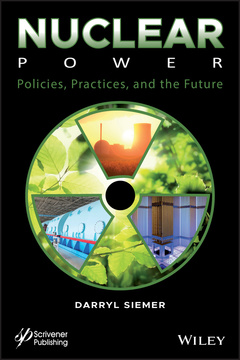Nuclear Power Policies, Practices, and the Future
Auteur : Siemer Darryl

As a ?whistleblower,? the author spent much of the last ten years of his career at the INL raising concerns about how its mission of serving as the Department of Energy?s lead laboratory in radioactive waste management was not being properly managed. While the United States continues to tread water on the issue of nuclear energy, the author believes that a nuclear ?renaissance? is not only possible but is necessary for meeting the world?s growing demand for energy, especially clean energy.
With fossil fuels slowly dying out and renewable energy sources not able to handle the demand for a continuously growing energy-consuming public, nuclear is an obvious solution. This book is a must-have for any engineer working in nuclear power, students hoping to go into that industry, and other engineers and scientists interested in the subject. This book is both ?technical? and ?political? because they?re equally important in determining what actually happens in institutions dealing with technical problems.
Introduction ix
1 Africa’s Especially Special Issues 1
2 Why Everything Boils Down to Energy Inputs 7
2.1 How Much Clean Sustainable Energy Will Our Descendants Need? 13
2.2 This Book’s Technological Fix’s Specifics 19
2.3 The Reasons Why Politically Correct Renewables Couldn’t Save the World 20
2.3.1 Which Food Crops Should Our Descendants Raise and How Much Land Would That Take? 24
2.3.2 The Whys and Costs of Desalination 26
2.3.3 Fertilizers 29
2.3.3.1 Nitrogen and the Cost of Fixing Enough of it to Feed Everyone 29
2.3.3.2 The Reasons Why Powdered Basalt Should Supply the Phosphorous and Potassium Required to Feed Everyone 30
3 A Sustainable Nuclear Renaissance’s Other “Killer Apps” 35
3.1 Atmospheric Carbon Sequestration 35
3.2 Nuclear Powered Transportation 40
3.2.1 Direct Electrical 40
3.2.2 Nuclear Powered Transportation Fuel Synthesis 42
3.2.3 “The Age of Substitutability” 47
3.2.4 Additional Apps 50
4 Why Sustainability Requires Breeder Reactors 51
5 Today’s More Promising Breeder Reactor Concepts 59
5.1 Heavy Water Thorium Breeders 59
5.2 Liquid Metal Fast Breeder Reactors (LMFBRs) 60
5.3 Molten Salt Reactors 62
5.3.1 MSFR 64
5.3.2 MCFR 66
5.3.3 MOLTEX 72
5.3.4 Tube in Shell Thorium Breeder 75
5.3.5 LFTR (Liquid Fluoride Thorium Reactor) 77
5.3.6 THORCON and IMSR 79
5.3.7 The Whys, Hows, and History of Sustainable Reactors 81
6 Economics: The Main Reason that the USA’s Nuclear Power Industry is Now on the Ropes 87
6.1 Generic Reactor Build Costs 100
6.2 Sustainable Reactor Build Costs 101
6.2.1 Materials 103
6.2.1.1 Concrete, Steel, etc. 103
6.2.1.2 Other Metals 105
6.2.1.3 Isotopically Pure Salts 106
6.2.1.4 Other Materials 107
6.2.1.5 Startup Fissile 107
6.3 Waste Management Costs 111
6.3.1 Waste Treatment 112
6.3.2 Waste Disposal 112
6.4 How Do We Pay for It? 116
7 The Nuclear Establishment’s Self-Inflicted Wounds 119
7.1 Refusal to Choose/Set Rational Goals 123
7.1.1 NGNP 124
7.1.2 DOE’s Savannah River Site’s MOX Boondoggling 126
7.1.3 DOE Hanford’s Reprocessing Waste Treatment Project’s Boondoggling 127
7.1.4 DOE’s “Lead Nuclear Engineering Lab’s” Radwaste Boondoggling 132
7.2 Fukushima’s “Nuclear Disaster” 137
7.3 The Nuclear Industry’s LNT-Based Radiation Dose Assumptions 141
7.4 ALARA (As Low As Reasonably Achievable) 143
7.5 Over Blown Proliferation Concerns 145
8 “The Damned Human Race” [196] 147
8.1 Greed 149
8.2 Tribalism 150
8.3 Gullibility 153
8.4 Laziness 155
8.5 Deviousness 156
8.6 Bullheadedness 157
8.6.1 Anti Nuclear “Environmentalists” 157
8.6.2 Hyper Secrecy 158
8.6.3 My Own Bullheadedness 160
8.7 Bullheadedness’ Consequences 160
8.7.1 INEL’s Calciner’s Off Gas “Opacity Issue” 160
8.7.2 Argonne Idaho’s IFR Waste Management Scheme 162
8.7.3 DOE’s Radwaste Classification System 164
9 Why the Western World’s Erstwhile Leader in Nuclear Energy Must “Embrace Change” 165
10 Suggestions for Improvement 179
11 Conclusions 185
References 193
Appendix I: Reprocessing 213
Appendix II: MSFR Isobreeder Fuel Salt Reprocessing 223
Appendix III: More Opinions about TERRAPOWER’s Reactor Concepts 225
Appendix IV: Example Additive Molar Volume Calculation 229
Appendix V: QBasic Startup Fissile Program 231
Appendix VI: A More Realistic Tube-In-Shell Thorium Breeder Reactor Startup Scenario 233
Appendix VII: Letter Sent to INEEL’s Director Circa 2001 (After “Separations” & Before “Steam Reforming” was the Site’s “Preferred Alternative”) 235
Appendix VIII: Letter Sent to Two of DOE’s Inspector General’s Lawyers Just after My Job Had Been Downsized for the Last Time 241
Appendix IX: Suggestions for Improving INL Reprocessing Waste Management 247
Appendix X: Greater Confinement Disposal 253
Appendix XI: How « hot » Are DOE’s High Level Wastes? 259
Appendix XII: How the Nuclear Industry’s «experts» Sometimes Mislead Us 261
Appendix XIII: Example of a Promising Concept that Needs Experimental Verification as Soon as Possible 265
Appendix XIV: INL’s Steam Reforming Process 269
Index 279
Darry Siemer, PhD, is a retired engineer who worked for the majority of his career at the Idaho National Laboratory (INL) in their nuclear fuel processing facility. He moved to INL after four years of teaching at Marquette University. Now a consulting scientist, he has taken on a mission to tell his story of his years working in nuclear energy as a means to educate engineers and scientists on the technological and policy-related issues surrounding nuclear power. He has dozens of book chapters to his credit as an author.
Date de parution : 10-2019
Ouvrage de 294 p.
1x1 cm
Thème de Nuclear Power :
Mots-clés :
Nuclear engineering



